Sunday 2nd May – Hollingbury, Brighton – A hot sun blazes down on dew sodden grass. Despite the encroachment of buildings onto the slopes of the South Downs, the landscape is unchanging. Mount Caburn to the north-east, a domed hill that was one of the line of Iron Age forts along the Downs. The name “Caburn” comes from the Celtic Caer Bryn and is, allegedly, the only Ancient British place-name in Sussex to survive the conquest of the Saxons. The woods of Newtimber hide another. The Ditchling Road winds up towards Ditchling Beacon which is hidden from here, it being another fort. On the side of one of the many dry valleys that edge the chalk ridge is the Chatri, a white marble monument built on the site of the funeral pyre for Sikh and Hindu soldiers who died of their wounds having been shipped back from France to Brighton in the Great War. All is green, grassy hills and shady woods alike. Many Sky Larks sing overhead and a persistent Great Tit calls nearby. Bluebells, Forget-me-nots and the strange yellow-green Sun Spurge grow on banks of rubble erected to keep Travellers off the fields.
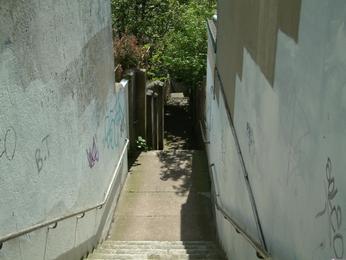
Monday 3rd May – Brighton – A wander through streets of memories for me. Firstly down Cat’s Creek, a steep flight on steps linking the bottom and higher part of Roundhill. Half way down there was a door, now boarded up. Behind the door, and the tall flint wall, were allotments, one of which my grandfather worked, and an orchard. I recall sitting in a pear tree eating the still rock hard fruit. Alas, although the fruit trees are still there, the ground is now just long grass. At the bottom of the steps is Roundhill Crescent. The buildings leading up from the Upper Lewes Road on the higher side is a long terrace of four storey high blocks of flats, Victorian I believe. My grandparents  lived on the third floor of the first one. Down the past terraced houses to the Lewes Road. St Martin’s School is now a residential property. Most of the shops have changed over the years, but a fish and chip shop remains, plants in the window where there were once trays of pease pudding. At the bottom of Elm Grove is a delightful little terrace of cottages. Along them reads an inscription “These Alms Houses were erected and endowed at the request of the late Philadelphia and Dorothy Percy AD1795”. Towards the sea, and the old Brighton Technical College where I worked many years ago is being converted into apartments. Across the Level, a long established area of grass, currently occupied by the now regular fun fair, and through the trees that have grown up since the destruction of the storm of 1987, St Bartholomew’s Church can be seen. A
lived on the third floor of the first one. Down the past terraced houses to the Lewes Road. St Martin’s School is now a residential property. Most of the shops have changed over the years, but a fish and chip shop remains, plants in the window where there were once trays of pease pudding. At the bottom of Elm Grove is a delightful little terrace of cottages. Along them reads an inscription “These Alms Houses were erected and endowed at the request of the late Philadelphia and Dorothy Percy AD1795”. Towards the sea, and the old Brighton Technical College where I worked many years ago is being converted into apartments. Across the Level, a long established area of grass, currently occupied by the now regular fun fair, and through the trees that have grown up since the destruction of the storm of 1987, St Bartholomew’s Church can be seen. A 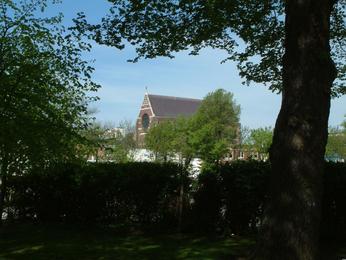 huge building, allegedly built to the dimensions of Noah’s Ark, it stands over streets that once were some of the worst slums in the town.
huge building, allegedly built to the dimensions of Noah’s Ark, it stands over streets that once were some of the worst slums in the town.
On past St Peter’s Church, the parish church of Brighton and on the opposite side of the road is a splendid terrace of Georgian bow-fronted houses. Past the lawns that divide the main road towards the sea front, past the famous Brighton Pavilion, a bizarre palace built for the Prince Regent (later George IV) by John Nash. Its minarets and eastern domed roofs are still a marvel. It is disappointing to see a plaque attached to building in the Old Steine dedicated to Gideon Mantell, an early palaeontologist is crumbling to dust. The sea front is crowded. Many are waiting for vintage commercial vehicles to arrive on their annual run from London. A solar-powered parking ticket machine stands on the kerb.  There is a plinth holding the anchor of the MV Athina B, a Greek merchantman that lost power and washed up on Brighton beach on a stormy night 21st January 1980. I remember it well, we were working in Browns Restaurant when we heard about boat coming ashore. Midnight was the start of my birthday and was spent in foul weather on Marine Parade watching the boat floundering about fifty metres off shore. Under the Promenade is the Brighton Angler. The shop used to be in the town, in Duke Street run by Ted. An old black and white photograph of him holding a decent flat fish is on display outside. I bought my first fishing rod there. I head up through The Lanes. In all the bustle of this much commercialised area, at the beginning of Prince Albert Street, is a peaceful garden and the Friends Meeting House. House Sparrows chirp merrily. On through the shopping thoroughfares of Bond Street, Gardner Street, Kensington Gardens and Sidney Street into Trafalgar Street. By now I am weary and my back hurts – a decent enough excuse for a pint in The George. I then wander up the London Road for a while before turning up Baker Street and ensconcing myself in The Mitre for a few pints of Harvey’s inestimable Light Mild.
There is a plinth holding the anchor of the MV Athina B, a Greek merchantman that lost power and washed up on Brighton beach on a stormy night 21st January 1980. I remember it well, we were working in Browns Restaurant when we heard about boat coming ashore. Midnight was the start of my birthday and was spent in foul weather on Marine Parade watching the boat floundering about fifty metres off shore. Under the Promenade is the Brighton Angler. The shop used to be in the town, in Duke Street run by Ted. An old black and white photograph of him holding a decent flat fish is on display outside. I bought my first fishing rod there. I head up through The Lanes. In all the bustle of this much commercialised area, at the beginning of Prince Albert Street, is a peaceful garden and the Friends Meeting House. House Sparrows chirp merrily. On through the shopping thoroughfares of Bond Street, Gardner Street, Kensington Gardens and Sidney Street into Trafalgar Street. By now I am weary and my back hurts – a decent enough excuse for a pint in The George. I then wander up the London Road for a while before turning up Baker Street and ensconcing myself in The Mitre for a few pints of Harvey’s inestimable Light Mild.
Saturday 8th May – Willowbank – Another wet weekend. The garden calls but it is so drenched in rain that gardening will cause more damage than good. Willowbank is brilliant green with all the trees now clothed in new leaves. There is little bird song in the drizzling rain. A very young foal follows its mother closely.
Home – A pair of Great Tits have young in the nest box on the top apple tree. They are in and out continuously. Pigeons have got at my Calabrese despite the flashing CDs hanging on string above the plants.
Tuesday 11th May – The Fleets – The pair of Mallard have produced eleven young. The ducklings follow their mother attentively – little balls of brown and yellow fluff bobbing on the water. There is a Common and an Arctic Tern fishing – successfully. When many plants are barely thinking about flowering, the Garlic Mustard seed pods are well formed. It is rather cold for May and very grey.
Wednesday 12th May – Barnsley Canal – The pair of Tufted Duck are on the canal at the foot of Willowbank again. They watch Dill the Dog nervously. A Sand Martin skims over the Hawthorn hedge. White Ladies Smock is in flower below the stone wall edging the tow-path. A female Blackcap ticks. There are several Wrens singing loudly. Clumps of Crosswort are beside the path and on the rough pasture. Tiny yellow flowers grow at the base of four leaves repeated up the stem of the flower. The courage of the Tufted Ducks desert them on our return and they fly swiftly off up the canal.
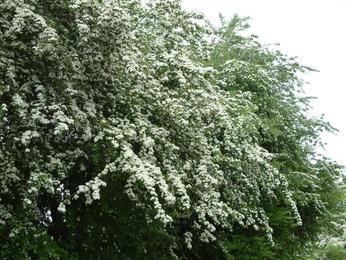
Saturday 15th May – Barnsley Canal – A bright sunny day with high cloud, which is clearing quickly. Although the song of the Chiffchaff is heard less now, the other warblers more than make up for it. Whitethroats, Blackcaps, Willow and Sedge Warblers are all in fine voice. Red Clover is in flower. Hawthorns are snowy with blossom. A Magpie crouches in the grass on Willowbank sunning itself. Pure white contrasts with the flash of orange on the wings of the Orange Tip butterfly.
Monday 17th May – The Fleets – Another bright Spring day. Columns of gnats rise above the banks of the River Dearne. Around the lake are dotted white pillows of flowering Hawthorn. Sunlight filters through the bright green swathe of leaves onto the path. Black-headed Gulls fly round the water calling. A pair of Swifts soar and swoop high overhead. In one corner is a stand of what seems to be Green Alkanet. It looks like a large Forget-me-not and is recorded as being rare in the UK. A loud splashing under the roots and bellied trunk of a willow reveals a pair of large Carp thrashing around as they mate.
Wednesday 19th May – Dearne Valley Park – A wander down the canal from Old Mill and on into the park. It is blustery with high luminous clouds. Whitethroats sing from the open land between the canal and Oakwell. The canal looks lifeless; patches of bronze green leaves and scum. There is no inlet or outlet to this section thus the water becomes somewhat stagnant. However, a couple of Moorhens jerk across the surface and Wrens dart into the overhanging bushes. Down in the park is a stand of head high Comfrey. Bees are feeding in the purple bell flowers. Chiffchaffs are calling all around. The descending call of Willow Warblers and the rich song of a Blackcap are also heard. There is a narrow lake running up from the main fishing lake. In the former is a small island and a Mute Swan is nesting on it. A Brimstone butterfly is a small splash of yellow against the brown of a broken down bank. A Speckled Wood suns itself beside the path.
Saturday 22nd May – Barnsley Canal – Another beautiful May morning. Warblers are singing from every direction. The ground is spotted white with the tiny petals of May flower – Hawthorn. A Reed Warbler is singing, jug jug, from the reed bed around a pond on the flood plain. A thin green caterpillar hangs by a thread from a Hawthorn. Small White butterflies are everywhere. Although not so abundant, there are still good numbers of the gorgeous Orange Tip. Loose bowelled cattle have been on the tow-path and Dill the Dog and I gingerly pick our way through the bespattered path. Crossing the flood plain towards the sewage works and the song of warblers is replaced by Sky Larks. Black-headed Gulls squabble further up the valley. Large black Carrion Crows and Magpies sit of fence posts. Approaching the small stream that crosses the fields from Low Barugh and warbler song takes over again. A Whitethroat and Wren sit atop the security fence. Further down a hidden Garden Warbler regales the world with its liquid song. Sand Martins swoop over the Dearne, feasting on the clouds of insects rising above the water. Back up towards the canal, discovering the herd of bullocks responsible for fouling the path. Dill the Dog coughs a cursory bark at them to clear the way. Another Reed Warbler is singing from the Loop. A Wall Brown butterfly resting on a reed is a surprise find.
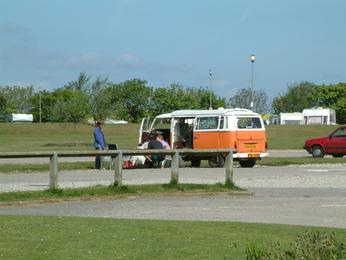
Sunday 23rd May – The East Coast – We pile into the charabanc (Dave’s VW Camper Van) and head off to the coast.
Filey – We park up and Dave sets about cooking breakfast – eggs, bacon, sausages, kidneys, black pudding, tomatoes, mushrooms and beans. About as British as you can get! The sun is blazing down, which it continues to do all day.  After breakfast, off to wander down Filey Brigg, a long finger of land sticking out into the North Sea. Sky Larks sing overhead and drop down into the long grass near the path. The is a brief glimpse of a Grey Seal, but sadly for Joy who has never seen one before, it fails to reappear. Cormorants, Kittwakes and Fulmar fly by. There was once an Anglo Saxon tower on the Brigg, but now the only remains are pits that once were gun emplacements. At the end of the path the ground falls steeply away to flat slabs of rock below. This rock is exposed at low tide and accessible by a steep path and steps down the side of the Brigg, We agree it is a long way down and an even longer way back up so just enjoy the view. There are a lot of people on the rocks so the Purple Sandpipers that frequent the area are missing. However, there are a good number of Oystercatchers and a Ringed Plover passes through with a brief pause. A Wheatear makes a brief appearance along the edge.
After breakfast, off to wander down Filey Brigg, a long finger of land sticking out into the North Sea. Sky Larks sing overhead and drop down into the long grass near the path. The is a brief glimpse of a Grey Seal, but sadly for Joy who has never seen one before, it fails to reappear. Cormorants, Kittwakes and Fulmar fly by. There was once an Anglo Saxon tower on the Brigg, but now the only remains are pits that once were gun emplacements. At the end of the path the ground falls steeply away to flat slabs of rock below. This rock is exposed at low tide and accessible by a steep path and steps down the side of the Brigg, We agree it is a long way down and an even longer way back up so just enjoy the view. There are a lot of people on the rocks so the Purple Sandpipers that frequent the area are missing. However, there are a good number of Oystercatchers and a Ringed Plover passes through with a brief pause. A Wheatear makes a brief appearance along the edge.
Bempton – A small village between Filey and Flamborough but a road leads off to Bempton Cliffs RSPB Reserve. 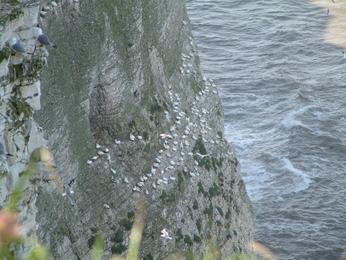 The path crosses a meadow to the cliff tops. A Sedge Warbler sings from a bush at the top of the slope. Along the cliffs is the constant calling of seabirds. Everywhere there is a view of a cliff face, there are Guillemots, Razorbills and Kittiwakes. On top of wider ledges, or in a long fault line in the limestone, are Gannets, snowy white bodies, creamy heads and long beaks. I had blithely informed all that we would see Puffins, without considering that at this time of year one of the pair would be incubating eggs in the burrows and the other at sea feeding. However, the RSPB warden and I did manage to find a few and give people a decent view through the scope. The warden then told me there was a Long-eared Owl over the other side of the car park and I should ask in the visitors centre as it was not being widely advertised. The centre was busy so I decided it would be better not to hassle them. I wandered over to the bank around the car park and scanned. There were
The path crosses a meadow to the cliff tops. A Sedge Warbler sings from a bush at the top of the slope. Along the cliffs is the constant calling of seabirds. Everywhere there is a view of a cliff face, there are Guillemots, Razorbills and Kittiwakes. On top of wider ledges, or in a long fault line in the limestone, are Gannets, snowy white bodies, creamy heads and long beaks. I had blithely informed all that we would see Puffins, without considering that at this time of year one of the pair would be incubating eggs in the burrows and the other at sea feeding. However, the RSPB warden and I did manage to find a few and give people a decent view through the scope. The warden then told me there was a Long-eared Owl over the other side of the car park and I should ask in the visitors centre as it was not being widely advertised. The centre was busy so I decided it would be better not to hassle them. I wandered over to the bank around the car park and scanned. There were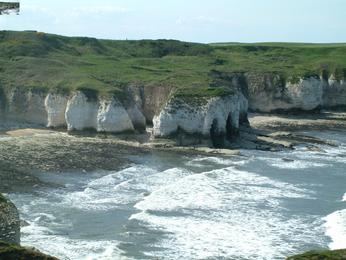 a couple of people near a dip full of gorse, willow and Hawthorn. Someone hailed me over – another warden. “Look through the scope”, he said. I looked through his scope and there was a magnificent Long-eared Owl sitting at the base of a bush. Its plumage was a beautiful mixture of browns with a pale yellow-buff wing bar. Ear tufts erect and eyes closed it remain motionless. I returned to the car park to get the others over to see this wonderful view.
a couple of people near a dip full of gorse, willow and Hawthorn. Someone hailed me over – another warden. “Look through the scope”, he said. I looked through his scope and there was a magnificent Long-eared Owl sitting at the base of a bush. Its plumage was a beautiful mixture of browns with a pale yellow-buff wing bar. Ear tufts erect and eyes closed it remain motionless. I returned to the car park to get the others over to see this wonderful view.
Flamborough – A couple of pints of beer were welcome in the café – we were getting very warm. There was a constant stream of small groups of Auks flying past. Gulls glided around the sea and cliffs. We wandered around the headland for a bit and decided we ought to head home to miss the majority of the traffic. In the event, the roads were still slow. We stopped off at the café on the forecourt of a petrol station in Dewsbury and had the most delicious Asian meal – five of eating for £37! By now we were a delightful shade of lobster.
Monday 24th May – The Fleets – Another day of blazing sunshine. The female Mallard sets off across the lake. She has lost two ducklings but still has nine. For some reason, a couple of Grey Herons are sitting in Hawthorn bushes beside the lake instead of their usual positions on the fishing platforms.
Thursday 27th May – Barnsley Canal – Another bright and dry morning, with just a breeze stirring the leaves. There is much less bird song now, a Chiffchaff calls from the topmost point of a Hawthorn and a Song Thrush belts out his rich fare from the hedge. A Little Grebe is further up the canal but disappears as soon as Dill the Dog approaches. The May blossom on the Hawthorns is fading. Forget-me-nots, Red Clover, Cuckoo Flower and Hop Trefoil are the main flowers in bloom. Marsh Horse-tails are prolific in the edge of the canal. A Common Pheasant crocks from across the fields. A Whitethroat sings near the footbridge.
Friday 28th May – The Fleets – A duller day with a steady breeze. A Common Tern floats in the air as it circles the lake. It dives several times to scoop water off the surface. A couple of Black-headed Gulls are also searching for food. A Bullfinch flies up from the path and slips silently off through the trees. Raspberries are forming on the canes on the far side of the lake; they are still tiny white fruits at the moment. Several young Robins are around the area. Giant Hogweed is developing into huge leaves and already four or five foot high either side of the weir.
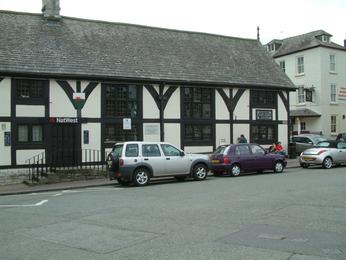
Saturday 29th May – Ruthin, Denbighshire, Wales – A market town not far from the English border and Offa’s Dyke. The town centre is at the top of a hill. St Peter’s Square contains some splendid half-timbered houses and one with an extraordinary long multi-dormered roof with seven 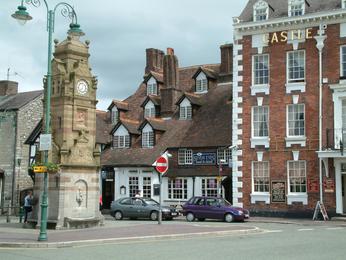 twindows looking down the hill. The pub that occupies the building is called Seven Eyes. The town was pretty much razed by Owain Glyndŵr in 1400 and 1402. The church – St Peter’s – stands behind the Post Office at the end of the square. The castle is now an hotel and thus we are unable to visit it. We head down the hill to the south east, past Record Street where the Library occupies a fine Grecian style building. Next door is the Police Station with “County Constabulary 1891” over the door. Past Dog Lane and to Railway Terrace. At first there seems to be no sign of a railway, but then a gate on one side of the road and a cinder track and a green area about the right size of a railway line is evidence of the vanished line. Our hotel, The Anchor, stands on the corner.
twindows looking down the hill. The pub that occupies the building is called Seven Eyes. The town was pretty much razed by Owain Glyndŵr in 1400 and 1402. The church – St Peter’s – stands behind the Post Office at the end of the square. The castle is now an hotel and thus we are unable to visit it. We head down the hill to the south east, past Record Street where the Library occupies a fine Grecian style building. Next door is the Police Station with “County Constabulary 1891” over the door. Past Dog Lane and to Railway Terrace. At first there seems to be no sign of a railway, but then a gate on one side of the road and a cinder track and a green area about the right size of a railway line is evidence of the vanished line. Our hotel, The Anchor, stands on the corner.
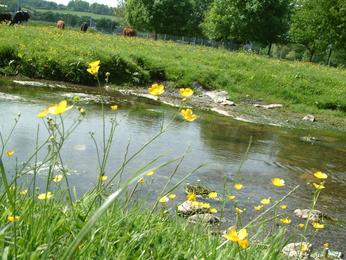
River Clwyd – We walk out of town on the Corwen road. The road is lined by some magnificent Limes. There is a substantial Edwardian House by which a footpath crosses a meadow. More fine mature trees are dotted around the fields. A substantial bridge stands over the River Clywd. A Grey Wagtail bobs across a shingle bar. People are relaxing on the buttercup filled water meadows. The footpath leads through small tunnel back into town. Well grown lambs still hassle their mothers on the slope leading down from the castle. Dill the Dog is in the river. Water Crowfoots (apparently not Crowfeet) are flowering – five pure white petals with a rich yellow centre sticking out of the water. Cows crop the rich grass.
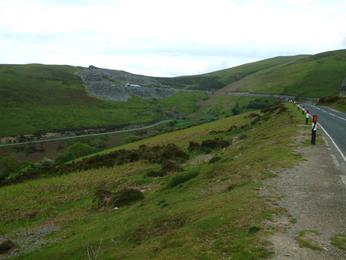
Sunday 30th May – Horseshoe Pass – Off to Llangollen. Through hedgerow-lined fields of sheep, lambs and the occasional Welsh Black cow. The road then passes through dense woodland with a rill flowing down a rough channel beside the carriageway. Climbing to the pass reveals a vista of meadows, copses, larger patches of woodland and boggy areas. The side of the hill, or is it a mountain, is scarred by quarrying. A Buzzard glides over the heather covered hillside. Horseshoe Pass is a road that runs around the top and then down the side of a classic glacial carved valley. A somewhat tasteless restaurant and gift shop is situated about ¼ mile before the summit. At the top of the pass at 1367 feet, Meadow Pipits call from a gorse and bracken covered hillside. Across the valley the side of the hills are long terraces of light grey sedimentary rock. Another slate quarry sits on the hillside advertising its blue-black slates.
Valle Crucis Abbey – Sited down the valley from Horseshoe Pass. A Cistercian Abbey founded in 1201 by Madog ap Gruffudd Maelor, ruler of Powys Fadog. Fire ravaged the abbey sometime shortly after this. There is no historic record of this event, but the earliest buildings show signs of a considerable blaze. The abbey was again badly damaged in the wars 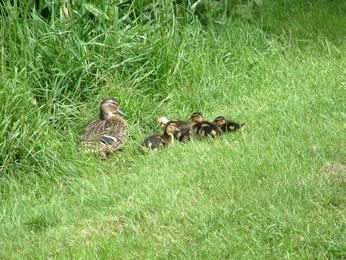 during the reign of Edward I. A high amount of £160 compensation was paid in 1284. The early part of the 14th century were prosperous and further building work was undertaken.
during the reign of Edward I. A high amount of £160 compensation was paid in 1284. The early part of the 14th century were prosperous and further building work was undertaken. 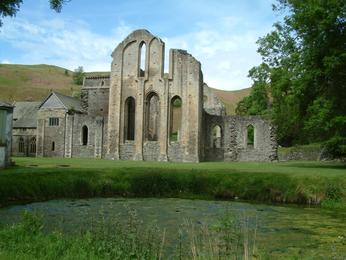 Its fortunes ebbed again in 1349 when the Black Death struck. They rose again in the middle of the 15th century. By now the Cistercian regime of austerity and plain living had given way to splendour and much consumption. When the abbey was evaluated in 1535 there were only six monks present and the buildings reported as in great decay. Under the dissolution, the abbey survived a while but was finally closed in 1537. Large parts of the abbey were robbed for building stone and in the later 16th century, Edward Davies moved into the precinct and probably converted the east range of the cloister into a dwelling. In the late 18th century, much of the abbey was used as a farm. During the 19th century archaeological excavations took place and restoration was begun. Sir Gilbert Scott was retained to oversee the repair of the west end of the church. The ruins are in a beautiful site in the valley, spoiled somewhat by being near ringed by a noisy camp site. The monks’ dormitory is in good condition and Swallows and House Sparrows are nesting within. Fledged Pied Wagtails are being fed by parents. Goldfinches cling to the walls. The fish stew, which would have provided carp for the non-meat eating monks, has been restored. A Mallard with ducklings has made it their home.
Its fortunes ebbed again in 1349 when the Black Death struck. They rose again in the middle of the 15th century. By now the Cistercian regime of austerity and plain living had given way to splendour and much consumption. When the abbey was evaluated in 1535 there were only six monks present and the buildings reported as in great decay. Under the dissolution, the abbey survived a while but was finally closed in 1537. Large parts of the abbey were robbed for building stone and in the later 16th century, Edward Davies moved into the precinct and probably converted the east range of the cloister into a dwelling. In the late 18th century, much of the abbey was used as a farm. During the 19th century archaeological excavations took place and restoration was begun. Sir Gilbert Scott was retained to oversee the repair of the west end of the church. The ruins are in a beautiful site in the valley, spoiled somewhat by being near ringed by a noisy camp site. The monks’ dormitory is in good condition and Swallows and House Sparrows are nesting within. Fledged Pied Wagtails are being fed by parents. Goldfinches cling to the walls. The fish stew, which would have provided carp for the non-meat eating monks, has been restored. A Mallard with ducklings has made it their home.
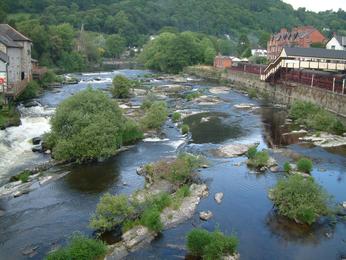
Llangollan – A fine arched bridge over the River Dee leads into the centre of the town. A steam engine is waiting to pull
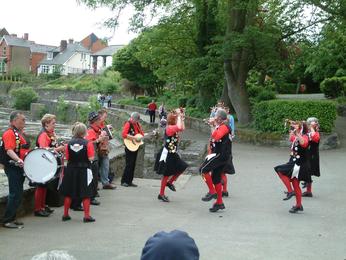 a train out of the station, but it is hidden around the bend. On the corner of the main street stands the Royal Hotel, somewhat in need of a lick of paint. The street is crowded and full of “gift” shops selling things that it hard to imagine anyone really wanting. The river is wide and shallow with large areas of flat stratas of rock rising out of the bed. There are numerous Mallard, many hybrids, and lots of ducklings in various stages of growth. Grey Wagtails bob on shingle banks. A Morris dance takes place with much jingling of bells and shouts. A narrow street leads along the other direction past the Royal. It is a fine mixture of different building styles. A Buzzard circles high over the wooded hills that rise behind the town centre.
a train out of the station, but it is hidden around the bend. On the corner of the main street stands the Royal Hotel, somewhat in need of a lick of paint. The street is crowded and full of “gift” shops selling things that it hard to imagine anyone really wanting. The river is wide and shallow with large areas of flat stratas of rock rising out of the bed. There are numerous Mallard, many hybrids, and lots of ducklings in various stages of growth. Grey Wagtails bob on shingle banks. A Morris dance takes place with much jingling of bells and shouts. A narrow street leads along the other direction past the Royal. It is a fine mixture of different building styles. A Buzzard circles high over the wooded hills that rise behind the town centre.
Llanrhydd – We spend the evening at a holiday cottage rented by some friends. The walk back to Ruthin is through narrow lanes bordered by high hedges. Numerous bats dart and dodge over our heads. A Tawny Owl calls in the distance.
Bank Holiday Monday 31st May – Ruthin – Walk across to the bridge and water meadows with Dill the Dog. She has an upset stomach after stealing and devouring a large lump of Bosnian sausage. There is a small weir built across the river just upstream beneath the bridge. It is broken at one end and the river flows normally under the bridge and out into the meadow. However, just discernable is a culvert under the track rising up to the bridge. The intact weir would have delivered the water through the culvert to a channel that runs down the bottom of the slope down from the castle. A Dipper flies downstream. The sun is rapidly burning the dew off the grass. Rooks are noisy in their rookery beneath the castle hill.
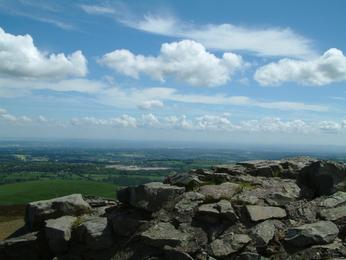
Jubilee Tower – The ruin of a tower Moel Famau, built about 1810 to commemorate the 50th anniversary of George III’s reign. The upper stages of which were blown down in a gale in 1862. It stands on the line of Offa’s Dyke. To reach the tower is a long steady climb from a car park that is fortuitously a long way up the line of hills. From the remains of the tower, the view is a magnificent 360° landscape. To the west is the Snowdon range, north to the coast, Prestatyn, Rhyl and then the Dee Estuary. Liverpool sprawls across the Mersey. Eastwards are the borders and Shropshire. To the south are the mid-Wales mountains. Then round to Calder Idris and back to Snowdon. Some of the hills in the range are topped by Iron Age forts, Foel Fenlly and Moel y Gaer. The Clywd valley, from which we have come, runs from the southern hills to the coast and is a splendid mixed landscape of irregular fields, copses and hamlets with Ruthin and Denbigh being the largest settlements. Heather and Bilberry cover the hillsides. The tiny flowers of Thyme and Eyebright twinkle beside the path.